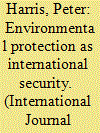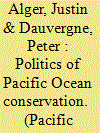|
|
|
Sort Order |
|
|
|
Items / Page
|
|
|
|
|
|
|
| Srl | Item |
| 1 |
ID:
140739


|
|
|
|
|
| Summary/Abstract |
The Commission for the Conservation of Antarctic Marine Living Resources (CCAMLR) adopted a conservation measure for establishing a network of marine protected areas (MPAs) in 2011. Since then, a number of proposals have been submitted to the Commission, but their designation has been consistently opposed by some pro-fishing CCAMLR member countries. This article provides an analysis of CCAMLR institutional and decision-making processes in an attempt to explain the obstacles preventing the creation of a network of MPAs. The role of environmental nongovernmental organizations (ENGOs) is examined through their track record in Antarctic environmental governance as well as the extent of their participation within the CCAMLR MPA process.
|
|
|
|
|
|
|
|
|
|
|
|
|
|
|
|
| 2 |
ID:
167536


|
|
|
|
|
| Summary/Abstract |
Blue carbon ecosystems are diverse and highly productive coastal habitats (mangroves, seagrasses, and tidal marshes) that sequester large quantities of carbon and provide a suite of important ecosystem services (‘co-benefits’) for humans and the environment. These ecosystems are being threatened globally due to land-use change driven by expanding agriculture, aquaculture, coastal development, and pollution. Climatic impacts further threaten the resilience, functionality, and adaptability of blue carbon ecosystems. ‘Marine protected areas’ (MPAs) provide a statutory approach for protecting coastal and marine ecosystems, yet are unlikely to meet ‘additionality’ requirements. Whereas other effective conservation measures (OECMs) including community-based ‘locally managed marine areas’ (LMMAs) provide opportunities to enhance blue carbon conservation and restoration efforts. LMMAs likely deliver additional sequestration, although ensuring ‘permanence’ of carbon stocks may be more difficult to achieve. This review summarizes key approaches of blue carbon monitoring; governance systems; policy instruments; and investment pathways for conservation and restoration.
|
|
|
|
|
|
|
|
|
|
|
|
|
|
|
|
| 3 |
ID:
150050


|
|
|
|
|
| Summary/Abstract |
The question whether coexistence of marine renewable energy (MRE) projects and marine protected areas (MPAs) is a common spatial policy in Europe and how a number of factors can affect it, has been addressed by empirical research undertaken in eleven European marine areas. Policy drivers and objectives that are assumed to affect coexistence, such as the fulfillment of conservation objectives and the prioritization of other competing marine uses, were scored by experts and predictions were crosschecked with state practice. While in most areas MRE-MPA coexistence is not prohibited by law, practice indicates resistance towards it. Furthermore expert judgment demonstrated that a number of additional factors, such as the lack of suitable space for MRE projects and the uncertainty about the extent of damage by MRE to the MPA, might influence the intentions of the two major parties involved (i.e. the MRE developer and the MPA authority) to pursue or avoid coexistence. Based on these findings, the interactions of these two players are further interpreted, their policy implications are discussed, while the need towards efficient, fair and acceptable MRE-MPA coexistence is highlighted.
|
|
|
|
|
|
|
|
|
|
|
|
|
|
|
|
| 4 |
ID:
135210


|
|
|
|
|
| Summary/Abstract |
Island bases are integral to US grand strategy in the Asia–Pacific. In this article, I discuss the increasingly common practice of using environmental protection initiatives to secure the Pentagon’s hold on these prized assets. I argue that nature reserves on or around militarized sites on Guam, the Central Pacific islands, and Diego Garcia serve to buttress US political control over the territory concerned. In short, nature reserves in the Pacific and Indian oceans give vital political cover to the island fortresses that they envelop by adding a public relations-friendly rationale for the US military’s occupation of colonized territories as well as an additional layer of politico-legal control.
|
|
|
|
|
|
|
|
|
|
|
|
|
|
|
|
| 5 |
ID:
147453


|
|
|
|
|
| Summary/Abstract |
In January 2016 New Zealand released a consultation document proposing a new act on marine protected areas designed to significantly reform current and now dated policy. This article explores those reform proposals in the context of the current regulatory regime, international obligations, and the best practice of selected other states. While the proposed act provides for a much firmer legislative base from which to develop an MPA network to conserve biodiversity and ecosystem function, nevertheless it is limited in geographic and functional scope. As such, it represents a missed opportunity and undermines New Zealand's claims to be an international leader in ocean management.
|
|
|
|
|
|
|
|
|
|
|
|
|
|
|
|
| 6 |
ID:
178282


|
|
|
|
|
| Summary/Abstract |
This paper interprets the disrupted establishment of the Kermadec Ocean Sanctuary, a 620,000 square kilometre marine protection area, as a crucial moment in Pacific frontier making. The development of large-scale protected marine areas is a politically charged frontier tool, in which states garner international recognition and environmental renown by setting aside large swathes of their exclusive economic zones. In the Kermadec Sanctuary, this enclosure hit against an assemblage of Indigenous histories, ecologies, repatriated fishing rights, and privatized fishing quota challenging the oft-marginalized agency of Indigenous people in frontier narratives. This paper argues that three factors are fundamental to untangling this conflict: first, the historical trajectory of terraqueous territorialization in the Kermadec region, second, the post-Treaty of Waitangi settlement dynamics of Māori marine environments, and third, the common ecosystem services model underlying conservation and extraction.
|
|
|
|
|
|
|
|
|
|
|
|
|
|
|
|
| 7 |
ID:
152073


|
|
|
|
|
| Summary/Abstract |
Drawing on seventy-four interviews, this article analyzes the rising importance since the mid-2000s of large marine protected areas (MPAs) as a policy for managing ocean conservation. Governments have initiated eighteen large MPAs (over 200,000 km2) since 2006, reflecting the emergence of a new large MPA norm in marine conservation. This norm, we argue, emerged because of the success of a few transnational nongovernmental organizations (NGOs) in identifying politically feasible large MPAs, and then forming ad hoc domestic coalitions to lobby for them. This explanation is in contrast to most of the literature on how and why norms diffuse internationally, as well as existing explanations for the rise of large MPAs, both of which emphasize the importance of cohesive coalitions of transnational NGOs lobbying in multilateral venues. This bottom-up, international norm diffusion strategy has made large MPAs a viable policy option, one national jurisdiction at a time. For instance, this strategy was a critical element in convincing the UK to create the Pitcairn Islands Marine Reserve (835,000 km2) in 2015. Given the politics underlying the formation of large MPAs, where political gains have been high, and corporate and societal resistance relatively low, the creation of more large MPAs would seem likely, as occurred in 2016 when the UK announced it would designate three more large MPAs by 2020, totalling over 1.4 million km2. Growing support for large MPAs as a conservation strategy could also embolden states to establish large MPAs in more politically and economically contested waters, including on the Pacific high seas.
|
|
|
|
|
|
|
|
|
|
|
|
|
|
|
|
| 8 |
ID:
114642


|
|
|
|
|
| Publication |
2012.
|
| Summary/Abstract |
Transboundary marine protected areas have been proposed in East Africa to tackle threats to marine biodiversity, meet international MPA targets, promote tourism, and contribute to poverty reduction. This article examines what may drive, facilitate, or constrain states in creating a regime for transboundary MPAs. In East Africa, a regime between Mozambique and Tanzania is not yet formed and may be indefinitely delayed due to oil prospecting and exploration. There is, however, a well-developed regime between Mozambique and South Africa that has resulted in the two adjoining MPAs being declared the first transboundary MPA on the continent.
|
|
|
|
|
|
|
|
|
|
|
|
|
|
|
|
|
|
|
|
|